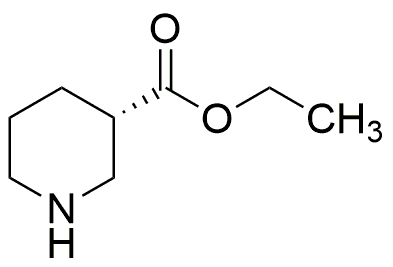(S)-Ethyl piperidine-3-carboxylate is widely utilized in research focused on
- Pharmaceutical Development: This compound serves as a key intermediate in the synthesis of various pharmaceuticals, particularly in the development of analgesics and anti-inflammatory drugs.
- Agrochemical Formulations: It is used in the formulation of agrochemicals, enhancing the efficacy of pesticides and herbicides, which helps in improving crop yield.
- Flavor and Fragrance Industry: The compound is employed in creating flavoring agents and fragrances, providing a unique scent profile that is desirable in consumer products.
- Research Reagents: It acts as a valuable reagent in organic synthesis, facilitating the production of complex molecules in academic and industrial laboratories.
- Biochemical Studies: This chemical is utilized in studies involving enzyme activity and receptor binding, contributing to the understanding of biochemical pathways and drug interactions.
General Information
Properties
Safety and Regulations
Applications
(S)-Ethyl piperidine-3-carboxylate is widely utilized in research focused on
- Pharmaceutical Development: This compound serves as a key intermediate in the synthesis of various pharmaceuticals, particularly in the development of analgesics and anti-inflammatory drugs.
- Agrochemical Formulations: It is used in the formulation of agrochemicals, enhancing the efficacy of pesticides and herbicides, which helps in improving crop yield.
- Flavor and Fragrance Industry: The compound is employed in creating flavoring agents and fragrances, providing a unique scent profile that is desirable in consumer products.
- Research Reagents: It acts as a valuable reagent in organic synthesis, facilitating the production of complex molecules in academic and industrial laboratories.
- Biochemical Studies: This chemical is utilized in studies involving enzyme activity and receptor binding, contributing to the understanding of biochemical pathways and drug interactions.
Documents
Safety Data Sheets (SDS)
The SDS provides comprehensive safety information on handling, storage, and disposal of the product.
Product Specification (PS)
The PS provides a comprehensive breakdown of the product’s properties, including chemical composition, physical state, purity, and storage requirements. It also details acceptable quality ranges and the product's intended applications.
Certificates of Analysis (COA)
Search for Certificates of Analysis (COA) by entering the products Lot Number. Lot and Batch Numbers can be found on a product’s label following the words ‘Lot’ or ‘Batch’.
*Catalog Number
*Lot Number
Certificates Of Origin (COO)
This COO confirms the country where the product was manufactured, and also details the materials and components used in it and whether it is derived from natural, synthetic, or other specific sources. This certificate may be required for customs, trade, and regulatory compliance.
*Catalog Number
*Lot Number
Safety Data Sheets (SDS)
The SDS provides comprehensive safety information on handling, storage, and disposal of the product.
DownloadProduct Specification (PS)
The PS provides a comprehensive breakdown of the product’s properties, including chemical composition, physical state, purity, and storage requirements. It also details acceptable quality ranges and the product's intended applications.
DownloadCertificates of Analysis (COA)
Search for Certificates of Analysis (COA) by entering the products Lot Number. Lot and Batch Numbers can be found on a product’s label following the words ‘Lot’ or ‘Batch’.
*Catalog Number
*Lot Number
Certificates Of Origin (COO)
This COO confirms the country where the product was manufactured, and also details the materials and components used in it and whether it is derived from natural, synthetic, or other specific sources. This certificate may be required for customs, trade, and regulatory compliance.


